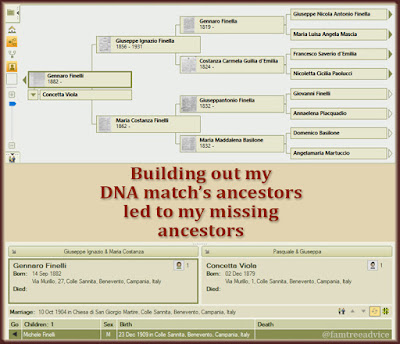I haven't created a list of next year's genealogy goals since 2020. I stopped because my techniques and my true mission kept evolving.
The best example of this is what happened after I finished this 2019 genealogy goal:
- Log 5 years' worth of birth records from each of my ancestral hometowns into spreadsheet.
I completed that goal, but my next project made my 2019 effort useless. The purpose of logging those 5 years of documents was to make it easier to search for any one person.
But I found an infinitely better method. And it was much easier to completely finish than adding to the spreadsheet. I renamed thousands of Italian vital record image files to include the name of the person and their father.
 |
| What's the next logical step to take in your genealogy journey? |
For example, here's how I renamed the 2nd birth record of 1809 in one of my towns:
The baby is Pasquale Maria Cernese (Maria is a common middle name for Italian baby boys), the son of Giovanni Cernese. With all the files renamed this way, I can easily search for all the children of Giovanni Cernese at once. I can run the Windows program called Everything and type in:
That'll show me a list of every possible child of Giovanni Cernese. My work is now a database that I share with other descendants of my towns.
I've explained this, my secret weapon, many times before. This time, it's a prime example of why I stopped setting annual genealogy goals. Instead, I'm constantly working on my tree and imagining how I can make the most of all that data.
So instead of making a 2023 Genealogy Goals List, let's look back for a moment. Let's take stock of our 2022 genealogy accomplishments. Then we can wrap up our genealogy year and dream up what comes next. I'll start. In 2022:
- I finished examining the 38,000 available vital records from Grandpa Iamarino's hometown of Colle Sannita. (See How to Use Your Personal Genealogy Database.)
- I made the names of all those files available to anyone who may search the internet for "Colle Sannita." (See How to Create and Share Your Ancestral Town Database.)
- I followed different types of genealogy leads to unexpected places. (See A Random Search Led to a Detailed Life Story.)
- I returned to my Genealogy To-Do List again and again to keep things interesting. (See Start Your Rainy-Day Genealogy List.)
- I used Family Tree Analyzer, the relationship calculator spreadsheet, and color-coding to see my family tree's facts and connections in different ways. (See How to See Your Cousin Connections More Clearly.)
- I spent November tying up a long list of loose ends in my family tree. (See Make November Genealogy Loose Ends Month.)
- I somehow managed to publish this blog every Tuesday!
As 2022 ends, I'll finish renaming the vital records from my other grandfather's hometown—Baselice. Then I'll be ready to piece together every Baselice family in my tree. And I'll publish my database for other descendants of the town to use.
 |
| One big goal is nearly finished, clearly paving the way for my next big genealogy project. |
Unless a new idea strikes me, I'll move on to another one of my ancestral hometowns. For me, that's what genealogy is all about. I'm claiming every last drop of my heritage.
What were your genealogy accomplishments in 2022? Where will that work lead you in 2023?




















